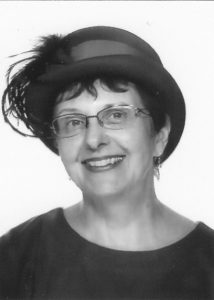Beth Skala

Beth Skala
Nanaimo, British Columbia
first driver’s licence—
showing friends
the cherry blossoms
Congratulations on having your haiku selected as the top winner in the British Columbia category in the Vancouver Cherry Blossom Festival’s 2016 Haiku Invitational contest. How did you first learn about haiku, and how much writing of haiku or other poetry have you done?
I first learned about haiku in grade school as a 5-7-5 formula that any child can write, or so they told us. It was not until I studied Japanese literature in college that I realized the genius of the classical haiku masters who said so much in so few words. While I have always written poems here and there, having some published on calendars and in anthologies, I did not seriously begin writing haiku until after retirement. Inspired by Naomi Beth Wakan’s workshops, I joined Haiku Canada and read many online articles on modern English haiku. I try to write poetry daily. Of all the poetry I write, haiku takes the most time and requires the most drafts before I am satisfied with the results. Even then, I sometimes reread my work later (often, unfortunately, after it has gone to print), and realize a word should be changed.
What was the inspiration for your winning poem?
Since “Celebrations” was the theme of the 2016 contest, I tried to think of the smaller celebrations in our lives, beyond birthdays and holidays and weddings. I remembered how excited I was when I got my first driver’s license, an experience well worth celebrating. I was sixteen and wanted to come up with a valid reason to borrow my parents’ car, a reason that would involve my friends so I could show off. I lived in a hot climate without cherry trees, but I could envision a new teen driver, eager to showcase his or her new skills, driving friends to see the cherry blossoms. I wish I had had that option. For any new driver, the cherry blossoms would provide a spectacular display to celebrate this rite of passage.
Describe the moment when you first learned you had won.
Whoopee! I did it again! (The first year I entered VCBF’s Haiku Invitational in 2011, I also won best British Columbia haiku.) I ran downstairs to tell my husband, and then emailed my family and my writing group (Pens Ultimate Nanaimo). Having my haiku selected affirms that I am making progress in my understanding of haiku, an encouragement I greatly appreciate.
Do you have favourite books or websites relating to haiku that others might benefit from in order to learn haiku as a literary art and to share one’s haiku?
I would recommend two books that have been helpful to me. The first is an old book (1958), An Introduction to Haiku by Harold G. Henderson. It is available as an e-book and there are lots of used copies online. The second is The Way of Haiku by Naomi Beth Wakan, available at her website. The author say she wrote the book for “absolute beginners,” though all writers of haiku would enjoy it.
Please tell us more about yourself.
I am a retired feng shui consultant and adult educator with a degree in Far Eastern studies from the University of Chicago. Writing takes up much of my time since I retired in 2008. I have self-published two chapbooks of poetry on aging and have two longer works in the final stages of proofreading for publication in 2017: My Mary Bennet (poems, letters, and miscellanea) and When Stones Choose You: Using Crystals in Feng Shui (nonfiction). My garden is a big draw, where I have an increasing collection of both bearded and nonbearded irises. Then there are photography, quilting, textile art, knitting, and reading, mostly nonfiction and science fiction. My husband and I enjoy taking courses at Elder College in Nanaimo and DVD courses from The Teaching Company. I also proofread for my adult children when asked.
How does where you live and what you enjoy doing affect the way you write haiku?
Living on Vancouver Island enables me to get outdoors most days, where the inspiration of nature is ever present. Usually I have camera in hand, which helps me focus on this natural beauty and really look at what is happening around me. Like my much-loved macro lens, haiku bring me up close to small details that mirror the larger world we live in. I have also started including poetry in some of my textile art. Because they are short, haiku are well suited to this collaboration.

